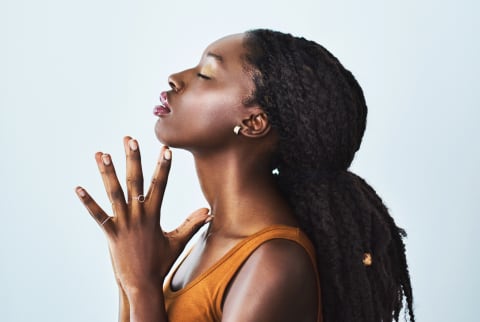A Holistic Psychiatrist Explains The Barriers To Mindfulness In The Black Community


Dropping into a meditation or mindfulness practice can be challenging for a variety of reasons. There's plenty of misconceptions about what mindfulness means, how to practice it, and what the benefits even are—but as holistic psychiatrist Kimberly Sanders, M.D., tells us, these barriers extend even more deeply into Black communities1.
Though they are at a higher risk of chronic stress and subsequent chronic health outcomes, Black communities have less access to mindfulness programs—i.e., programs that could support both physical and mental health. Here, Sanders explains those barriers to entry and provides tips for starting a mindfulness practice in the face of them.
Barriers to mindfulness in Black communities:
Lack of access to health resources.
"Overall, a lot of health resources are not accessible to Black communities," Sanders says. Mindfulness is just one of them. Integrative medicine doctor Eudene Harry, M.D., once wrote "Black people are at increased risk for a variety of chronic diseases2 such as diabetes, strokes, heart disease, cancer, and kidney disease."
These statistics are due to systemic racism, which leads to a lack of cultural humility within the health care system that discourages Black, Indigenous, and other people of color (BIPOC) from seeking treatment or prevents them from getting quality treatment (be sure to check out the 10 tools to help Black patients advocate for their health).
There aren't as many Black teachers.
First and foremost, "there aren't many Black teachers or providers offering mindfulness," Sanders says, "so there are fewer people talking about it within the community." If someone is able to get past those barriers to entry, there are also barriers to engagement once they've arrived, she says.
"I think a lot of times if you're in a room full of non-Black people and the instructor is giving references, those references may not land with you the same way," Sanders says. "Then what you're doing is spending this mental energy trying to extrapolate the metaphor so that it makes sense for you when you should be using that mental energy to get into the practice."
Mindfulness is not always viewed as "helpful."
One of the misconceptions about mindfulness is that it is only helpful in managing mental health, like depression and anxiety. "But there are a lot of studies coming out about how mindfulness is helpful for metabolic issues3, like diabetes, weight management, and cardiovascular risk4—I don't think these benefits are as well known in the Black community," Sanders says.
Mindfulness is often associated with religion.
"A lot of the time, there's a conflation with mindfulness and religion," Sanders says, "and particularly with the Black community, there's an issue about whether you can be Christian and practice mindfulness." By addressing this misconception, Sanders says more people may be open to it.
How to start a mindfulness practice.
Though there are known barriers to entry, Sanders says mindfulness is essential for healing in Black communities. "We're trying to heal from generations of trauma that have impacted our DNA and the continued racism within our country that impacts our health on a day-to-day basis," she says.
Mindfulness is a tool that not only alters your physiology, but it's also a tool you can have with you all the time. "Once you learn it, it becomes a way of being, a way of moving through the world and healing throughout," Sanders states.
If you're new to mindfulness, here are a few ways she recommends getting started:
- Start by understanding what mindfulness is. According to Sanders, "mindfulness is a nonjudgmental present-centered awareness," which means, rather than quieting your thoughts, you're allowing yourself to sit with them. It's about "being able to experience whatever sensations occur, whether we deem them pleasant or unpleasant. The point is, we're not judging them or trying to take action," she explains.
- Use a guided meditation app. Sanders recommends Headspace and Calm as good introductions. "Also, Shine meditation app is made by POC and has voices of many people of color leading meditation," she adds. You can also take mbg's 14-Day Guide to Meditation led by meditation teacher Light Watkins.
- Start slow. Keep your first meditation to about three minutes, she suggests, and if seated meditation is too challenging, you can do a walking meditation. "It can be a really hard thing to start, so if you're new to it, give yourself some grace and compassion," she notes. "If you can do it for an hour each day, then that's great, but if you can't, even two minutes will be helpful."
- Try informal mindfulness practices. Meditation, yoga, breathwork, and other formal practices are helpful, but starting with informal mindfulness practices can benefit you, too. That is: bringing awareness into your everyday actions, such as showering, eating, walking, etc.
- Follow and learn from Black instructors: Here are a few Black yoga, meditation, breathwork, and other mindfulness experts, teachers, and programs Sanders recommends following: Chelsea Jackson Roberts, Davina Davidson, Herself: Kim Sanders, M.D., Melanin Moves, and OMnoir. For more, here's a list of 40-plus Black spiritual thought leaders, organizations, and studios.

Abby Moore is an editorial operations manager at mindbodygreen. She earned a B.A. in Journalism from The University of Texas at Austin and has previously written for Tribeza magazine. She has covered topics ranging from regenerative agriculture to celebrity entrepreneurship. Moore worked on the copywriting and marketing team at Siete Family Foods before moving to New York.